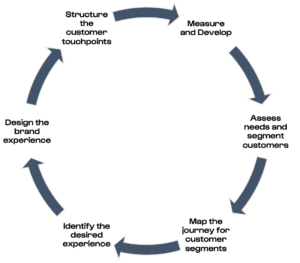Mapping the Buyer’s Journey, Customer Experience Style
The challenges that arise for CX within the buyer’s journey are often more complex with companies that are focused on selling to other businesses rather than direct to consumers. A challenge to B2B customer-experience efforts is the fact that customer journeys are simply more complex than those for retail customers. B2B companies often have more offerings and services than B2C companies. The offerings are also highly tailored to individual customer needs and often consist of different products and services bundled together. In our experience, most B2B companies have far more critical customer journeys on which to focus than the ten that many B2C players average. B2B journeys also tend to be long, complex, and quite technical, and consist of a continuous interaction of services and sales touchpoints. Journey experience and operations are often fragmented by account and location, involving multiple teams in different departments.
 For example, the export-financing journey of one financial institution involved four organizations: the financial institution itself, the importer, the exporter, and an export insurance company. The journey required one and a half to two years to complete and included many highly technical components that bedeviled redesign efforts. Among the technical elements that required expertise to redesign were detailed financial data, as well as extensive compliance inputs and risk assessments. The financial institution, therefore, included a lawyer and a financial analyst in its customer-experience-redesign team to ensure enough technical expertise to address these elements.
For example, the export-financing journey of one financial institution involved four organizations: the financial institution itself, the importer, the exporter, and an export insurance company. The journey required one and a half to two years to complete and included many highly technical components that bedeviled redesign efforts. Among the technical elements that required expertise to redesign were detailed financial data, as well as extensive compliance inputs and risk assessments. The financial institution, therefore, included a lawyer and a financial analyst in its customer-experience-redesign team to ensure enough technical expertise to address these elements.
Creating Tracks
B2B journeys often grow complex because they must accommodate the special needs of small percentages of the client base. Such relationships require specific tailoring, extra services, or additional checks. Splitting the journey into standard and specialty tracks can minimize complexity for a majority of clients, resulting in easier journeys for clients and significantly lower costs.
One European corporate bank radically redefined the customer journey into three tracks, helping clients and employees better understand how complex international financing deals could get approved. An express track was set up for relatively easy deals that entailed low risk and could be executed with fewer checks, smaller teams, and shorter timelines. An advanced track for more difficult deals included extensive auditing, the addition of senior executives to the working team, and more interactions with the client. Between these two was the standard track. After reviewing a proposal, loan officers map the risk indicators and choose the track that includes the most conservative approach to processing the deal.
That begs the question—how much of this is relevant to my business where my customers are other businesses?
Mapping the Buyer’s Journey
It’s really simple—automate the predictable and humanize the exceptional. Customer experience projects have traditionally been heavy, design thinking-inspired affairs with journey maps, secret shopping, and lots of sticky notes. But it really comes down to a process that you define internally:

- Assess needs and segment customers: Define the customer needs in terms of products and/or services along with how those needs divide them into specific groups of your customer base.
- Map the journey for customer segments: Create a journey that each customer segment goes through to meet their needs with your organization.
- Identify the desired experience: Determine the ideal experience for the customer segment that matches their journey; the optimal progression of the experience.
- Design the brand experiences: Define how your business will deliver the ideal experience in accordance with your brand.
- Structure the customer touchpoints: Identify and map at what points within the journey that your organization will touch the customer through marketing, sales, and customer service.
- Measure and develop: Measure the impact of the journey and continually hone and improve the process.
For a more detailed overview of developing your customer experience strategy, this comprehensive guide is a great way to internally jumpstart your organization. If you aren’t sure where to start, then it’s time to get a baseline for your customer experience internally via the Customer Experience Assessment—a free tool that will provide you the tools to improve and develop your customer experience.



